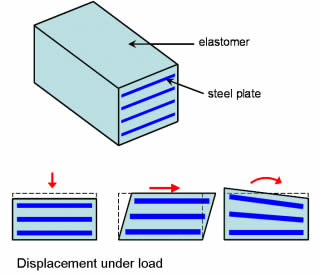For composite steel bridges, the bearings undergo relatively large rotations during construction (i.e. the weight of wet concrete, any superimposed dead loads, creep and shrinkage in the deck).
For long spans, this rotation could be close to the rotation capacity of the bearing, e.g. ~0.015 radians for elastomeric bearings. This would leave no further ability to rotate and limits the allowable vertical loads on the bearings. In fact, it is a requirement in my local code that the faces of the elastomeric bearing are parallel at the completion of construction.
In my case, elastomeric bearings are really preferable because they keep the superstructure fairly well isolated seismically, which improves the design. Spherical bearings, while having a large rotation capacity, are probably not an option in this case because they will attract enormous earthquake forces which would have to be designed for.
I am wondering what options there would be to avoid over-rotating the elastomeric bearings during construction, such that they end up essentially at 'zero rotation' by the time construction has finished? I suppose using temporary bearings during construction and installing the permanent bearings after most of the rotation has occurred would be one option, but not sure how practical this is. Any other ideas?
For long spans, this rotation could be close to the rotation capacity of the bearing, e.g. ~0.015 radians for elastomeric bearings. This would leave no further ability to rotate and limits the allowable vertical loads on the bearings. In fact, it is a requirement in my local code that the faces of the elastomeric bearing are parallel at the completion of construction.
In my case, elastomeric bearings are really preferable because they keep the superstructure fairly well isolated seismically, which improves the design. Spherical bearings, while having a large rotation capacity, are probably not an option in this case because they will attract enormous earthquake forces which would have to be designed for.
I am wondering what options there would be to avoid over-rotating the elastomeric bearings during construction, such that they end up essentially at 'zero rotation' by the time construction has finished? I suppose using temporary bearings during construction and installing the permanent bearings after most of the rotation has occurred would be one option, but not sure how practical this is. Any other ideas?

